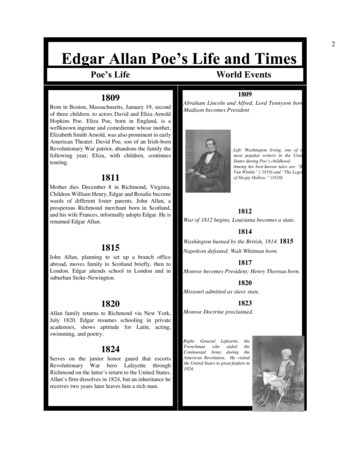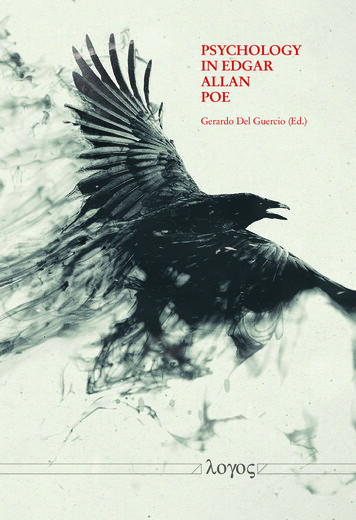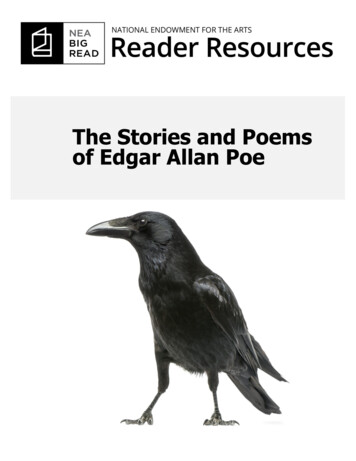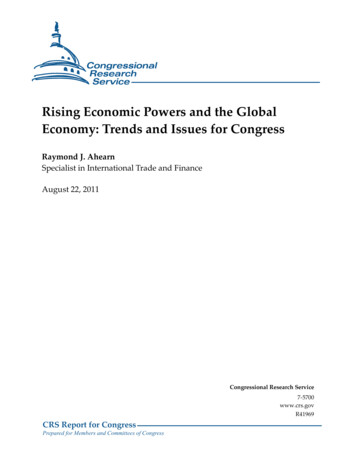
Transcription
Poe and the Powers of the MindRobert ShulmanELH, Vol. 37, No. 2. (Jun., 1970), pp. 245-262.Stable URL:http://links.jstor.org/sici?sici O%3B2-ZELH is currently published by The Johns Hopkins University Press.Your use of the JSTOR archive indicates your acceptance of JSTOR's Terms and Conditions of Use, available athttp://www.jstor.org/about/terms.html. JSTOR's Terms and Conditions of Use provides, in part, that unless you have obtainedprior permission, you may not download an entire issue of a journal or multiple copies of articles, and you may use content inthe JSTOR archive only for your personal, non-commercial use.Please contact the publisher regarding any further use of this work. Publisher contact information may be obtained athttp://www.jstor.org/journals/jhup.html.Each copy of any part of a JSTOR transmission must contain the same copyright notice that appears on the screen or printedpage of such transmission.The JSTOR Archive is a trusted digital repository providing for long-term preservation and access to leading academicjournals and scholarly literature from around the world. The Archive is supported by libraries, scholarly societies, publishers,and foundations. It is an initiative of JSTOR, a not-for-profit organization with a mission to help the scholarly community takeadvantage of advances in technology. For more information regarding JSTOR, please contact support@jstor.org.http://www.jstor.orgTue Mar 18 11:40:45 2008
POE AND THE POWERS OF THE MINDBY ROBERT SHULMANI n his best fiction Poe achieves acute insights into the mysteries,processes, and terrors of the human personality without drainingour shared inner life of its basic mystery. After all the attacksand denigration, after all the emphasis on his dubious metaphysicsor even more unfortunate personal pathology, we can still go toPoe's fiction for illumination that writers of a more psychologicallysophisticated era are oddly handicapped from providing. I n Poecriticism that usually implies bad news-more necrophilia andincest, more maternal deprivation and twisted sex. But by stressing Poe's concern with the powers of the mind and the situationof the poet, I want to recall attention to some of the other psychological and intellectual matters that make Poe a living force.The most interesting Poe criticism of the last decade has established that Poe's aesthetics and cosmology are central to an understanding of his fiction and poetry. I propose to reverse the usualrecent emphasis and, while taking Poe's theory seriously intoaccount, to emphasize the psychological revelations of the fiction.Whereas the usual psychological study of Poe treats the fictionas an unconscious manifestation of the author's problems or asan unconscious confirmation of orthodox Freudian categories, itseems to me that in his best stories Poe has a genuine understanding of unconscious processes and imaginative p0wers.l Inthe psychological criticism, Poe often emerges as a rather bedraggled victim of tendencies he failed to understand. My view,however, is that in much of his fiction Poe had unusual insightinto often obscure mental processes and that, although he maynot have grasped consciously all the implications-what humanbeing ever does?-for purposes of his art he had remarkableThe classical psychological study of Poe is Marie Bonaparte, The Life and Worksof Edgar Allan Poe: A Psychoanalytic Study (London, 1 9 4 9 ) . Although it is toorigid in many ways, Marie Bonaparte's book is sensitive to basic impulses in Poe'simagination and seems to me to deserve renewed attention, in contrast to David M.Rein, Edgar A. Poe: The Inner Pattern (New York, 1960).Robert Shdman245
understanding and control. Before trying to develop this view,however, since Poe has a consciously formulated theory of themind, we must first consider the bearing of that theory on hisimaginative understanding of our complex inner life.I n his Longfellow review (1842) and " The Poetic Principle "(1846 ff .) -the more revealing fiction will come later-Poe dividesthe mind into the three faculties of Intellect, Taste, and the MoralSen e. Taste, we recall, is the most important faculty, since itdoes not deal with Truth or moral values but with Beauty andfinally with that ideal, supernal Beauty, Unity, and Perfectionthat, on Poe's view, man and the universe originated in and havesince fallen away from into the multiplicity, disintegration, and" state of progressive collapse " we now know.3 Eventually theuniverse will disintegrate, Poe argues in Eureka, personal identity will be lost, but, more than compensating for this " inevitableannihilation " (XVI, 186), the original, Divine Beauty, Life, andUnity will prevail. I n the meantime, under the guidance of Taste,by rearranging earthly forms and through suggestive imagery andmusic, poetry can begin to satisfy our inborn thirst for this eternalBeauty and Divine Perfection. By exciting our souls, Taste andthe poem can elevate us and give us the insight we crave, thevision of eternity, the vision of an eternal realm of Beauty andUnity superior to anything we can know on earth.Poe's landscape essays are allegories on this view of the mindand universe; or rather, on those phases emphasizing poeticbeauty, not annihilation and collapse. It is no wonder, then,that " The Domain of Arnheim " and the others have found fewreaders, just as it is fortunate if symptomatic that there is sucha split between the emphasis on Beauty and Perfection in Poe'stheory, particularly his critical theory, and the emphasis on darkerqualities in his best fictioa4 For Poe, through the soul-excitingThe development of Poe's critical theory is traced by Marvin Laser, " The Growthand Structure of Poe's Concept of Beauty," ELH, 15 (1948), 69- 44. See also GeorgeKelly, "Poe's Theory of Beauty," American Literature, 27 (1956), 521-536 and" Poe's Theory of Unity," PQ, 37 (1958), 34-44; and Joseph J. Moldenhauer, " Murderas a Fine Art: Basic Connections Between Poe's Aesthetics, Psychology, and MoralVision," PMLA, 83 (1968), 284-297.Edgar Allan Poe, Eureka, in The Complete Works of Edgar Allan Poe, ed. JamesA. Harrison (New York, 1902), XVI, 300. My quotations from Poe are from theHarrison edition and the citations will appear in the text.4Poe has a marked tendency to compartmentalize his interests and insights, andalthough the deepest personal sources of this tendency are outside our present con-246Poe and the Powers of the M i d
elevation of Taste and the poem--or what unpredictably amountsto the same thing, through the terrifying catastrope of death andannihilation-for Poe the highest aim of the self and the universeis to lose individuality and multiplicity, to go beyond the natureand life we know, and to become one with the Divine Unity andBeauty. That Poe has intensely mixed feelings about this processis suggested by the discrepancy between the dominant tone andrevelations of most of his fiction and the dominant tone andemphasis of his theoretical pieces.One example out of many is that, although Poe frequentlymentions the elevated soul striving for Loveliness, his explicitcritical theory does not take account of his major contributionto fiction, his imaginative understanding of the self, creating andsuffering under the pressure of obsession, hatred, and dread. Poe'scosmological theory, to select another example, stresses disintegration as a prelude to Unity with Divine Beauty, but, althoughobsession and madness are types of disintegration, the more general and philosophical terms conceal much of what is actuallygoing on in stories like " The Tell-Tale Heart " or " The Masqueof the Red Death." Poe's vocabulary and concepts disguise muchof his actual accomplishment. To be even more specific, and toreturn to our starting point, Poe's model of the mind in his critical essays allows no place at all for a depth dimension, no provision for what the tarn, the abyss, and the dark, hidden chambers in his fiction suggest-that realm associated, not with supernalBeauty but with conflict, chaos, hostility, and fear, the depths hispower comes from, much as Poe would like it otherwise and rettier. A case in point is " The Masque of the Red Death," oftenadmired for its suggestive atmosphere and formal unity or ascern, we should note that Poe regarded poetry as superior to and more refined thanprose, so that he was apparently liberated to explore in detail in his prose fictionmaterial he felt was unworthy of poetry and which he did not choose to discussexplicitly in his theoretical work. Nina Baym, "The Function of Poe's Pictorialism,"SAQ, 65 (1964), 46-54, also concentrates on the split between Poe's theory andpractice.Poe develops his model of the mind-Intellect, Taste, the Moral Sense-inhisreview of Longfellow's "Ballads and Other Poems," Graham's Magazine, April, 1843.The faculty of perversity, first mentioned in " The Black C a t " a year later (August19, 1843), is never assimilated into Poe's developed poetics. His summary statementof his mature poetics, " The Poetic Principle " (1846 ff.), uses the same three facultiesas the Longfellow review.Robert Shulman247
evidence that Poe was impelled to imagine ultimate annihilation,even that of an entire community, or as evidence that death ismerely a prelude to a not undesirable union with Divine processand perfection.' The story is more immediately an allegory onPoe's scheme of the mind-he published " The Red Death" amonth after his Longfellow review-and from the start it suggests Poe's dissatisfaction with that faculty of Taste his theorywould lead us to expect him to present sympathetically. PrinceProspero, as his name indicates, represents one style of artistand imaginative man, the embodiment of one style of Taste,apparently frolic but actually terrified of impending madness.His magnificent palace, a variant on " The Haunted Palace" ofthe mind and the House itself in "The Fall of the House ofUsher," is " the creation of the prince's own eccentric yet augusttaste " (IV, ,250) . It is absolutely isolated from the rest of theworld and from the other faculties of the mind; in this secludedpalace, " it was folly to grieve, or to think " (IV, ,251) , which arefor the Moral Sense and Intellect.Poe has real insight into that basically irrational strategy bywhich the mind attempts to preserve itself from its own forcesof madness, disease, and disintegration by rigidly isolating itselfand by assuming that the threat is external when in fact it isinternal. This poetic mind, ostensibly given over to pleasure andBeauty, is actually given over to what it fears most, to those" sudden impulses of despair or of frenzy from within " (IV, 851)which, because of the unbreakably bolted doors, can neither escapenor originate in the outside world.The dark labyrinth of the mind, excluded from Poe's formaltheory, is richly (and perhaps overrichly) represented in the storyby those irregular chambers of the mind, lighted not by the naturalsun but by flickering torches filtered through dark Gothic windows and emblematic of the prince's strange imagination-some" thought him mad" (IV, 853). The prince's " own guidingtaste " had decorated the bizarre interior of the palace and hadalso " given character to the masqueraders " who " stalked, infact, a multitude of dreams" (IV, ,254), through these luridchambers. The protagonist is understandably threatened by the'See, e. g., R. W. B. Lewis, Trials of the Word (New Haven, 1965), p. 207 andJoseph P. Rappolo, "Meaning and 'The Masque of the Red Death,'" in Poe: ACollection of Critical Essays, ed. Robert Regan (Englewood Cliffs, N. J., 1967), pp.134-144.248Poe and the Powers of the Mind
black clock of mortality and impending decay. I n the inmostrecess of his palace, the prince finally confronts the one fear hehad refused to admit-Poe often takes a phrase or figure ofspeech literally-and Poe brings to a climax his suggestive allegory on the decay, madness, and disintegration of a mind exclusively given over to Taste; increasingly terrified of insanity, decay,and death; and altogether shut up in its own concerns andprocesses. Where Hawthorne might deal with the morality ofisolation, Poe achieves remarkable insights into the irrationaldefenses of the mind, and into irrationality itself. I n his imaginative work, even when he is deliberately using his formal modelof the mind, Poe does not confine himself within the limits ofthat theory but suggests processes that, though they may originate in his personal preoccupations, have a disturbing and revealing general relevance." The Masque of the Red Death " suggests that we might stayalert to Poe's tendency to be ambivalent about, to disguise, andto vary his treatment not only of the concerns he stresses in histheory but also in his fiction. We should not be surprised that awriter with Poe's imaginative understanding of the ordinarily concealed recesses and powers of the mind and universe should inhis fiction emphasize ordinarily suppressed emotions, processes,and terrors or that he should to some extent conceal what he wasrevealing, as he does in " The Masque of the Red Death " (originally published as " The Mask of the Red Death ") , or that heshould seek to imagine more satisfying alternatives, as he doesin the critical and landscape essays, some of the poems, and partsof Eureka. The problem for criticism is to understand and evaluate the results.One major tendency in recent Poe criticism is to reconcile theserious differences in empha,sis within and between Poe's theoryand fiction by assigning priority to his aesthetic and religiousvalues and by stressing them in interpreting the imaginativework.' The comic and satiric pieces aside, however, Poe's fictionSee, e. g., Moldenhauer; Rappolo; Kermit Vanderbilt, " Art and Nature in ' TheMasque of the Red Death,"' NCF, 22 (1968), 379-389; Richard Wilbur, "EdgarAllan Poe," in Major Writers of America, ed. Perry Miller (New York', 1963),I, 373-380 and " The Poe Mystery Case," NYRB, 9 (July 13, 1967), 16, 25-28; JosephM. Garrison, Jr., " The Function of Terror in the Works of Edgar Allan Poe," A&, 18(1966), 136-150; and Edward Davidson, Poe: A Critical Study (Cambridge, Mass.,1957).Robert Shulrnan249
succeeds to the extent that he can suggestively, precisely, andintensely illuminate the interior of the self, the powers and processes of the mind-and frequently the destructive and irrationalpowers. The stories can have profound implications for the universe, as in " The Fall of the House of Usher " and " A Descentinto the Maelstrom," but they are less successful when the emphasis is almost exclusively cosmological, as in " The Conversation of Charmion and Eiros," or when Poe relies almost exclusively on melodramatic atmosphere, as in " The Assignation," sothat his ability to probe inner states is not also called into play.The melodramatic trappings designed to suggest depth, mystery,and obscurity are not a major distraction when, instead of beinga substitute for profundity, the depths are in fact explored, as in" The Masque of the Red Death."Poe often seeks to find metaphoric equivalents for his explicittheoretical concerns-with identity and oneness in unexpectedguises, with the importance of analogy, with the life and deathpower of writing and art to stimulate supernatural and finallyfatal visions, with the terror and awe of moving from life to deathto a strange afterlife or of swooning and awakening to strangeperceptions, novel sensations, and " t o the verge of some stupendous psychal discoveries."I n a typical story, through theswooning or dizziness of the protagonist and through symbolicsetting-a journey to the interior of foggy, secluded ravines orthe dark, inner chamber of a castle or the hold of a ship-Poeorganizes a series of episodes to suggest his main theoretical concerns and to establish unconventional states of mind in whichordinary reason and common-sense are superseded and strangemergings, suggestions, and discoveries can occur. " The settingof a Poe story," as a recent critic says, " is not an external worldat all, but the world of imagination made substantial for thepurpose of coming to know i t better."But in contrast to " A Descent into the Maelstrom," " TheTell-Tale Heart," or " The Cask of Amontillado," in his lesserworks-" A Tale of the Ragged Mountain," " The PrematureBurial," or " Morella," for example-Poe's revelations about the" A Tale of the Ragged Mountains," V, 174. For Poe's account of his experimentswith the state between waking and sleeping, see the Marginalia for March, 1846,XVI, 87-90.Baym, p. 47.Poe and the Powers oj the Mind
interior of the self and the powers of the mind are relativelygeneralized and tame, relatively less precise, less profound, andless intense than in his major fiction. One ravine is very muchlike another, ten swoons are not necessarily more suggestive thanone, and Poe, as he is always tempted to do, relies heavily onmechanical conceits, strained effects, and overinsistent rhythmsand rhymes. Although they illuminate facets of Poe's aestheticand cosmological theory, stories like " A Tale of the RaggedMountain " and " Morella " do not pass beyond the possibilityor " verge of some stupendous psychal discoveries." I n his moresuccessful work, however, the " discoveries " are precisely andsuggestively explored, often through Poe's strategy of sustainingtension between an ordered prose and an irrational subject matteror of dealing in a meticulously organized story with the powersof chaos and disintegration, or through Poe's ability to imagineand bring to fictional life his major symbols-the abyss, thedarkened chambers, the teeth and eyes that animate much of hisbest work.Perhaps the most significant pattern in Poe's career is thathe developed the ability and technical control during the late1830's and early 1840's to probe sharply those inner states andpowers he had earlier suggested only quite generally and " philosophically." The contrast between " M S Found in a Bottle "(1833) and " A Descent into the Maelstrom" (1841) is anexample of this tendency. When, as in many of the stories of1844, Poe reverts to more generalized fiction related in themeand tone to his theoretical views, the quality declines, as thecontrast between " The Tell-Tale Heart " (Jan., 1843) and " Mesmeric Revelation" (Aug., 1844) illustrates. Since the development of Poe's fiction is often overlooked, these changes in approach and quality are worth stressing to counter the impressionthat for all practical purposes the stories were written a t the sametime and that they can be best appreciated from the perspectiveof Poe's consciously articulated theory.We must now turn to some major stories to suggest how, inways his theory disguises or overlooks, Poe does in practice sustain precise, revealing insights into the powers of the mind anduniverse. H e has, for example, a well-known ability to dramatizeour latent powers of hostility and the destructive, cruelly punitiveimpulses which animate the recesses of the mind and which findRobert Shulrnart25 1
their proper symbolic setting and enactment in "the inmost recesses of the catacombs " (VI, 171) in " The Cask of Amontillado." Less well-known but equally revealing are the insightsinto the destructive powers of hostility, drinking, and thwartedcreativity Poe dramatizes in " Hop-Frog."I n one of modern literature's most moving versions of the tortured, alienated artist, Hop-Frog, jester to the King, is presentedas a deformed dwarf and cripple, a stranger in the midst of othermen, marked off from them by his foreign origins, his suffering,his talent, and his deformities. Hop-Frog's crippled movements,excessive sensitivity to wine, and rebellious subservience to hispublic further constitute an early portrait of the literary man asa drunk and an unwilling toady-hop, frog-those two guises forthe artist that in the century to follow will be repeated againand again both sympathetically and hostilely. Hop-Frog, a t themercy of his employer, suffers indignities, watches his lady friendbeing callously abused, and, despite his protests, is forced &stto drink the two glasses of wine he cannot stand and then tosatisfy his employer's demand for " invention," for " characters,"for " something novel-outof the way" (VI, 219). I n thussuggesting a relation between drinking and writing, Poe placesthe blame for the drinking outside, on the cruel demands of thepublic, so that from Poe's point of view the account is self-excusing and partly true (the damage his own drinking did his wifeis reflected and deflected by having the King throw the wine inthe companion's face). More profound and fully dramatized isPoe's insight into the dynamics of destructive hostility andthwarted creativity, into the impulses the wine releases andallows Hop-Frog to express.Poe shows that Hop-Frog's powerless subservience to his public is combined with thwarted creative power, represented partlyby the powerful teeth, arms, and chest above the crippled legs.The image of the parrot's beak grating remorselessly against itscage, the harsh noise dominating the entire chamber, is onemajor symbol of the resulting hatred, frustration, and threatening, aggressive contempt the caged artist turns against those whohave degraded him into a parrot, no nightingale or raven. Thecruel noise dominates the final scene of awful revenge and turnsout to be the grating of Hop-Frog's fang-like teeth, so that beakand teeth, in other contexts perhaps suggestive of masculine crea252Poe and the Powers of the Mind
tive power, here further our insight into creative energies thwartedand turned to destructive uses." Inspired " by the wine, Hop-Frog turns to new uses an oldstory by Froissart and, with their own consent, by tarring andfeathering King and court, chaining them, and dressing them asapes, he makes a monkey of his public as he feels they havemade a parrot of him. I n another of Poe's Gothically darkenedchambers of the mind, Hop-Frog, " with the rapidity of thought "(VI, 816), then illuminates the mind's destructive powers in histerrifying h a 1 action. At the climax, the chamber's one sourceof light, the lamp, traditional symbol of imaginative creativity,becomes an implement of vicious torture and the abused, cagedvictim has been goaded into inhuman, all-too-human victimizer.For those who cannot separate the story from their knowledgeof Poe's life and death, perhaps the most painful turn is the sensethat, whatever the origins in Poe's drinking, imaginative blocking, and difficulty in writing, whatever the actual tangle of rightsand wrongs, one of our most gifted writers was impelled a t theend of his life to image his career in just this way. The finalpathos for " the imagination at play," as Terence Martin puts itin another context, is that at the end Poe " imagines our death." '"Our immediate concern, however, is with the center of Poe'sartistic achievement, his ability to understand imaginatively thedarker and sometimes the creative powers of the human mind,as he does in " A Descent into the Maelstrom." I n this story andin Poe's fiction generally, the dominant powers are most oftenthe inner and outer forces of chaos and irrationality. ,4t theclimax of " A Descent," however, just as the protagonist is aboutto be destroyed in the whirlpool, the counter forces of reason andimagination do help save him from that abyss of existence whichalso suggests the chaotic depths of the mind. Freudians mightmore particularly identify the smooth, funnel-like whirlpool withan entry through the mother-sea into the womb, an entry theprotagonist is intensely curious about but which he also fears willdestroy him until he finally emerges from this chaotic region ofdeath and birth, a changed, suddenly aged new man. Certainlythe rhythms of near death and a precarious new birth are involved, but the impulse toward and away from the womb isnot the only revelation in this exploration of the depths. Aslo "The Imagination a t Play: Edgar Allan Poe," KR, 28 (1966), 209.Robert Slzulnzan2.53
another part of Poe's drama of mental powers, through luck,observation, reasoning, and above all a flash of intuition, theprotagonist, we recall, is saved from inner and outer chaos. SinceCharles Feidelson has emphasized that the loss of personal identity is often the price Poe's narrators pay for the " exciting knowledge " they crave and fear, we should stress that in " A Descent,"Poe suggestively reveals the precarious, saving powers of reasonand imagination as well as the destructive energies, impulses, anddepths of the mind and universe, and our fascination with theseinescapable depths and dangers.''Richard Wilbur has observed that Poe often models his storieson the descent into the dream state, and another basic model forhis fiction emerges in " A Descent." l 2 I n this story, Poe apparently transformed and universalized his own experience of alcoholic fugue states-thedizziness, the roaring in the ears, thedescent into unconsciousness, and the emergence, interestinglyenough through the agency of a water-cask, so that Poe puts tothe uses of suggestive inner exploration not only the public interest in voyages of discovery but also his own more privateconcerns." The Purloined Letter" and the other tales of ratiocinationare the obverse of works like " MS Found in a Bottle " and " ADescent into the Maelstrom." As Richard Wilbur and EdwardDavidson have shown, the poetic mind's unequivocal masteryover both ordinary and extraordinary men and circumstancesthis dramatizing of the superiority of the poetic power of imagination gives the Dupin stories much of their urgency, distinguishes them from the ordinary detective story, and constitutes alarge part of their appeal.13 Like the man in " A Descent,"Dupin is a careful observer, so that he is not cut off from theoutside world, but the important creative insights are achievedin the Gothically darkened chambers of his room and mind," among recesses of thought altogether inaccessible to the ordinary understanding " (" The Murders in the Rue Morgue," IV,148) . Using Dupin's " truly imaginative " mind as his standard,Poe subjects to quiet ridicule those more routine mental habitsthe Inspector represents.Symbolism and American Literature (Chicago, 1953), p. 36." Edgar Allan Poe," p. 378.Wilbur, " Edgar Allan Poe," pp. 379-380 and Davidson, pp. 213-2122.254Poe and the Powers of the Mind
As a law officer, the Inspector is an authority figure, an embodiment of some of the dominant values of his nineteenth-centuryAmerican society. He is thorough, diligent, practical, and common-sensical; he works hard, methodically, and dully. His approach is inductive and Baconian, as Poe defines these terms inEureka. Part of the mechanism of the tales of ratiocination is toshow the superiority of the poet over the inspector, to put theauthority figure in the power of the poet, to reverse the ordinaryrelations and, in a world that devalues poetic power, to affirmthat power at the expense of practical men of affairs. Throughhis imaginative, intuitive ability t o perceive analogies, to respondto oblique hints, to place himself in the mind of another, and tosee things " as a whole " (IV, 1 6 6 ) , as the esemplastic imagination should, the poet surrogate easily wins the gold a t the expenseof the respectable police official and the influential politician. I n" The Purloined Letter" an inverted letter appropriately contributes to the success of this disguised man of letters. I n " TheMurders in the Rue Morgue," in addition to the conflict with theInspector, another main source of interest is the contest betweenthe intuiting, reasoning mind and the brute horror of things, acontest the imaginative mind controls from start to finish.To show the superiority of the poet and his imaginative powers,Poe also carries the attack into the citadel of science by arguingstrongly against the supremacy of mathematics as a means ofgetting at " general truth " (" The Purloined Letter," VI, 44) .Dupin, like Poe himself, has mathematical and analytical gifts,because on Poe's mature view of the mind " the truly imaginativeare never otherwise than analytic " (" The Murders in the RueMorgue," IV, 150), but the imaginative power is the comprehensive one." Because the Minister D is also a poet and mathematician, he is, as his initial suggest, a double of Dupin and isthus sympathetically treated until the surprising and unpreparedfor turn against him in the final paragraphs of " The PurloinedLetter," a turn that cannot be fully explained by Poe's need toend the story in an interesting way. I s it that Poe, reactingagainst the prevailingly low estimates of the poet and againstl 4 A month before he published " The Purloined Letter " (Jan., 1845), Poe wrotein his ,llarginalia about " the silent analytical promptings of that poetic genius which,in its supreme development, embodies all orders of intellectual capacity" (Dee., 1844;XVI, 29).Robert Shulman455
criticisms of himself as a failure and " an unprincipled man ofgenius " (VI, 58), turns these charges against the Minister D inhis role as successful man of affairs and, using the dreadfulThyestes myth, punishes the successful man as a failure? Oris it that Poe, who has elevated the imaginative powers throughDupin, also partly accepts the conventional negative judgmentand expresses it through the final treatment of the double, theMinister D?Whatever his reservations, however, a t the center of the talesof ratiocination Poe dramatizes the triumph of the powers ofimagination. More characteristic, and more characteristically66psychological," are Poe's stories about the destructive, not thecreative, powers of the human mind, as in his studies of the crueldynamics of obsession and self-punishment. The punitive animosities turned against others in " The Cask of Amontillado "and " Hop-Fr
Poe develops his model of the mind-Intellect, Taste, the Moral Sense-in his review of Longfellow's "Ballads and Other Poems," Graham's Magazine, April, 1843. The faculty of perversity, first mentioned in "The Black Cat" a year later (August 19, 1843), is never a










